 (Click for Dutch
version)
(Click for Dutch
version)
Welcome to the content of the folder with the striking finds. Unfortunately I can not
show everything because it lacks a lot of background information. Furthermore, some items
where unusable because of the damp conditions it was once stored in. Especially the unique
pictures suffered a lot. It is therefore a pity I can not show all the pictures (maybe on
a later date when they all are restored). But I will share the most important findings with you.
I can assure you that my heart skipped sometimes a beat, when for instance I came across the
Spitfire NF Mk XXV, with the Rolls-Royce Titan Mk 16 or the Firecat, and what to think of the
Twin-Spitfire…
I whish you happy browsing and remember, if the jet had not spoiled it all, what interesting
Spitfires could have seen the light of day?
Some of the drawings had some touching up done and had to be ‘unwrinkled’.
To bring you the best quality, I had to use some extra memory and therefore the download may take
some time, my apologies for that.
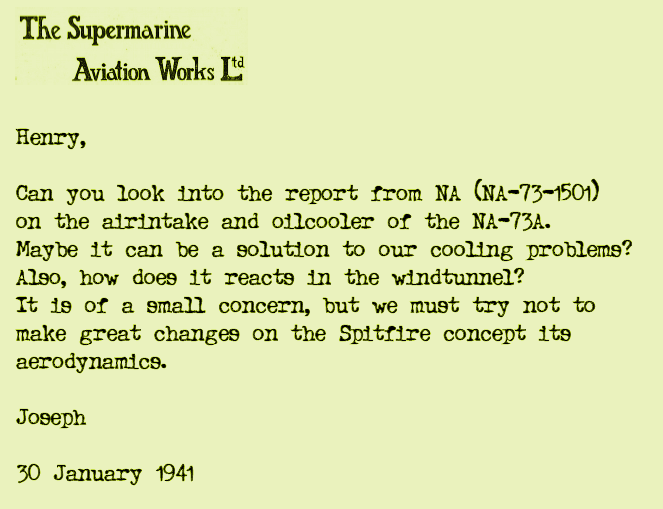
One of the first things in the folder was a memo from Joseph (Smith) to the head of
the technical department at Vickers. It took a while to browse through the papers to figure this memo out.
It turned out to be the air intake under the fuselage of the NA-37, the prototype of the P-51 Mustang. There is a
request to see if this is a solution for the Spitfire to solve the cooling problem, but also the question not to forget
the distinctif aerodymics of the Spitfire.
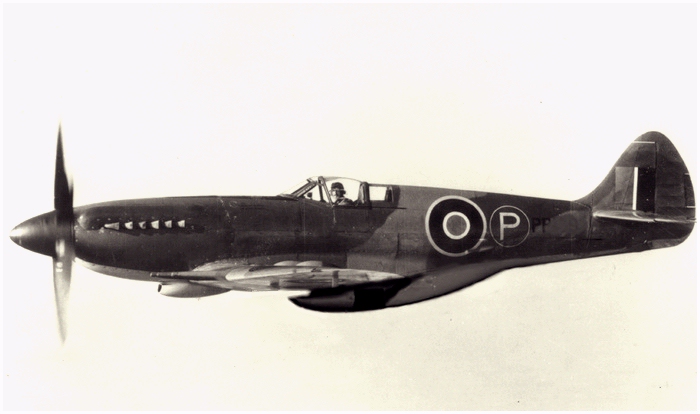
A protoype Spitfire Mk XIV(37) with the P-51 air intake under the fuselage
That no hurry was made with this cooling system is clear from the picture above showing a prototype Mk XIV(37) that
was built in the course of 1943. There is also, as far as I known, only one built with this system. There would be too much change
to the existing design, which would delay the production of the regular Spitfires at that time.
Furthermore, the cooling with the existing two oil coolers under the wings turned out to work properly.
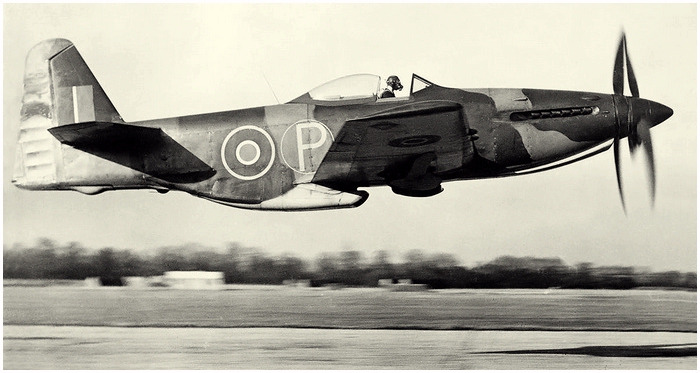
The prototype of the MB 5 (with the P-51 air intake) gets airborne
Vickers decided to shelf further development, but Martin-Baker used the idea for their MB 5.
Those who were lucky to fly this aircraft
unanimously stated that this was a fantastic hunter. Unfortunately it did not go into production to test it in
conflict. I could not find any evidence of it, but it is not unlikely that Vickers and Martin-Baker have cooperated in this field,
because it is known that the two worked together. For instance,
Martin-Baker made improvements to the ammunition supply for the Spitfire and the
armor behind the seat of the pilot. This may explain that when Martin-Baker received the request, from the Ministry of Aircraft Production,
to research the use of ejection seats on airplanes, they received help from Vickers. Because of
this was done in secret during the war. For a short time
an adapted trainer, a T.9, was used by Martin-Baker before they switched to the Gloster Meteor in 1946.
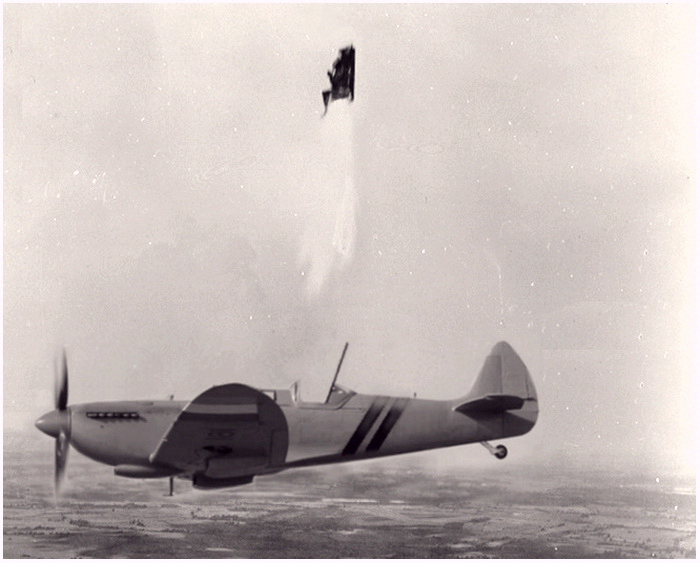
One of the early ejection seat tests from a Spitfire T.9
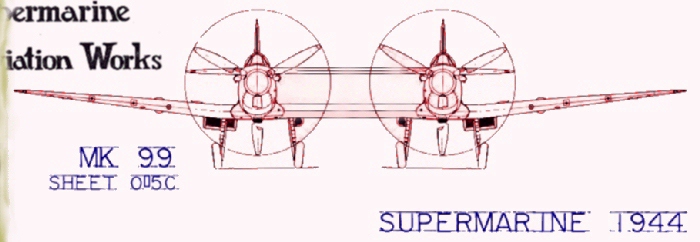
Supermarine Mk 99 Twin-Spitfire
One of the more promising Spitfire projects was the Twin-Spitfire Mk 99. Inspired by the American
design of the P-82 Twin-Mustang, Supermarine started to research the possibility if the Spitfire could
also be converted in that way. It was a slow progress because a lot of time was wasted on where to place
the pilot and navigator/radar operator (In the UK they drive on the left side of the road). But the
constructors finally went for the international option. With international sales in mind, they placed
the pilot on the portside. Only some drawings are preserved of Sheetproject 10099 Tw Mk 99.
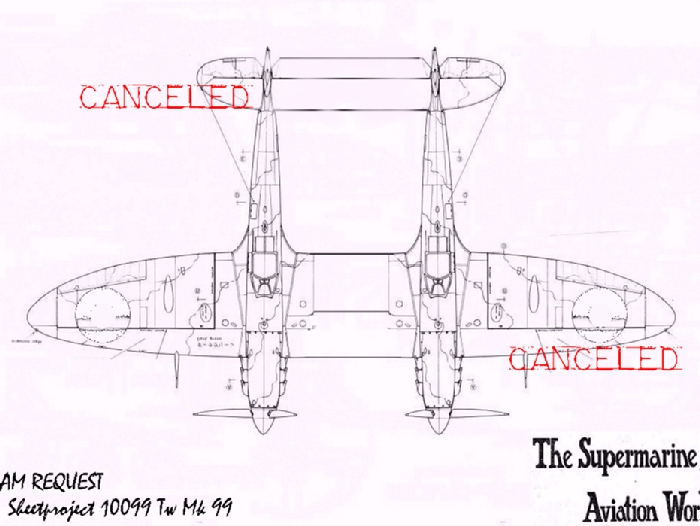
Supermarine Twin-Spitfire
The next generation of the Twin-Spitfire, the Mk 199, was introduced in 1946. It was basically
constructed out of two F.21 fuselages. Had the original Mk 99 an elevator rudder connection between the
tail sections (see drawing above), on the Mk 199 this was deleted. Research showed that it disturbed the
airflow in a rather negative way. And this configuration made it different to the Twin-Mustang.
Because of the deleting of the connection there was a problem to overcome with the cables to the rudders
of the tailplane. Supermarine had a revolutionary solution to the problem, the rudders became electric
powered for a better synchronism. It is known that the (or they?) prototype, the LA333/334, made a few
testflights. What became of the aircraft afterwards is unknown. Because of the topsecret development
only one picture was released, but one with some heavy censorship (see below).

Supermarine F. Mk 199 Twin-Spitfire
A project that was waiting for the go-ahead, was the successor to the T9, the trainer version of the
Mk IX that was operating with great success in Holland and Ireland. But because of the fast development
of the jetfighter, it was built only as a prototype and it never came to production orders.

Supermarine Spitfire TX-900
The unique
feature on this version was the introduction of a low bi-plane. The intructor and trainee had the same
position as in a normal Spitfire F.XIV (this differs from the T9 where the trainee was brought forward
so the instructor had more room in the back). The T-900 was to be constructed out of two F.XIV fuselages
with wings bolted together to built one trainer version. But first, a prototype of two Mk V's were 'molten'
together and was registerd as Type 900A.
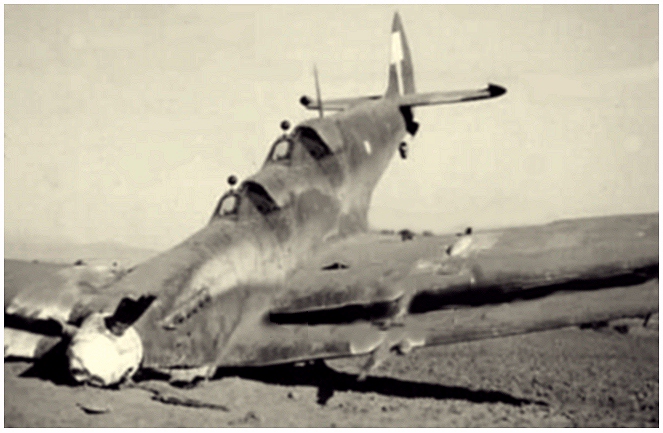
Spitfire Type 900A after the first 'flight', and belly landing...!
(The picture suffered from damp, but I will nevertheless share it with you)
When the first flight was made is unknown (somewhere in the summer of 1946) and ended in disaster.
The handling was
very troublesome because of the poor aerodynamics. The airflow over the first wing created a reversed
effect on the second wing. This made it very difficult to lift the 900A from the runway. When it
finaly lifted, it was hard work to stay aloft, and the 900A had to make a belly landing.
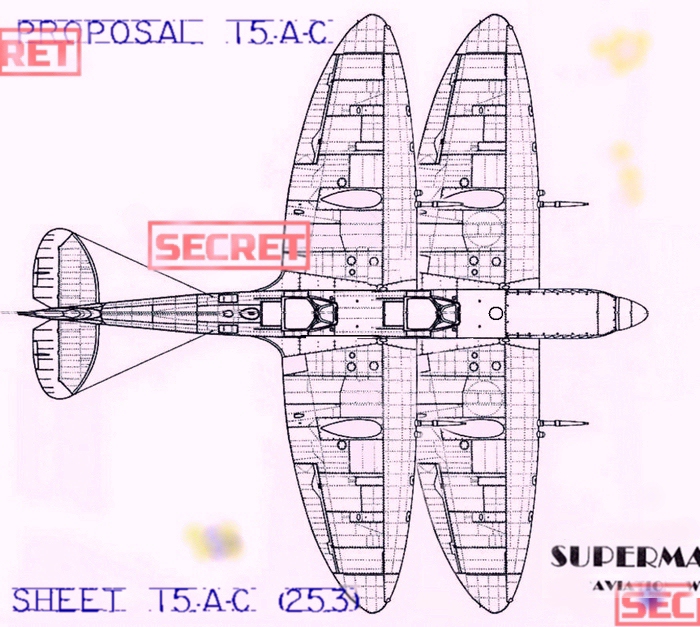
The endeavours
with this Mk V 900A prototype were soon cancelled. After this failed first project, two Mk IX's fuselages
were put together and designated as AT-900. First flight was in December 1946 and all the problems with
the aerodynamics were solved one step at the time.
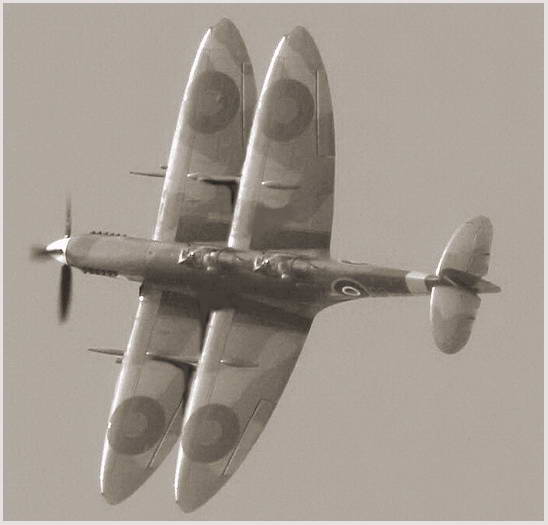
The prototype of the Spitfire AT-900
(picture taken august 1947 from an Avro Lincoln bomber)
(Because of the blow-up, the sharpness is not that great)
The final version of the Mk T-900 project would have the Griffon 61 (2005 hp)
and was (theoretically) to reach a speed of around the 705 km/h. Testing the AT-900
went well and with the aerodynamic problems solved, the final version was created.
Two F.Mk XIV's were used, and designated as the AT-900B (RN222). It kept her complete armament
so it could be used as a heavy ground-target attack plane.

Spitfire AT-900B during a testflight
(At the back of the picture a date of ‘27 March 1949’ is written)
The AT-900B lacked the trainer facilities, so a navigator could be
placed in the rear. The prototype of the AT-900B (RN222) was flown with great success, but it never went into production.
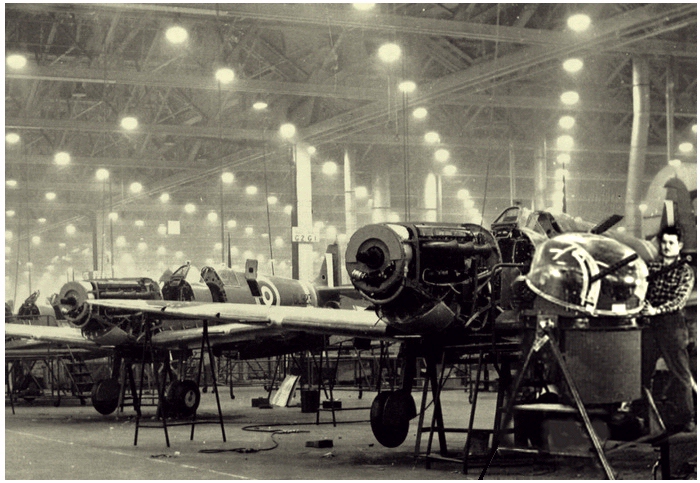
A Martin gunturret in a factory from Supermarine?
The next project that I came across needed further research when I saw a picture with in the right bottom
corner what seemed to be a .50 gunturret from a bomber. I soon did found the answer that the turret was
an American made Martin gunturret (no connection with Martin-Baker).
But what was did doing in a factory of Vickers-Supermarine? After some rummage through the stacks of
documents that mentioned, the following information came up,...
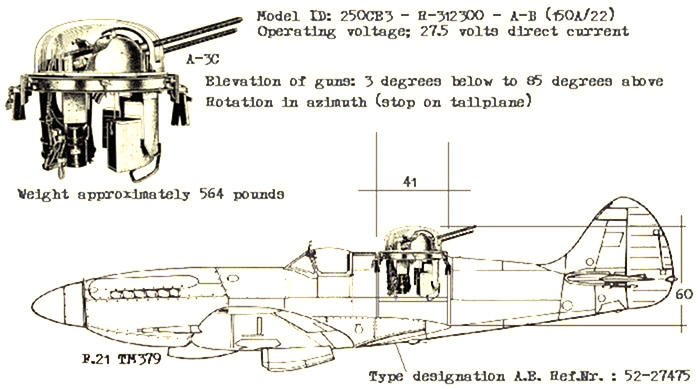
The rear gunturret returned, this time in a Spitfire Mk.21
After the short existence at the front of the Bouton-Paul Defiant, the fighter
with a gunturret behind the cockpit, it looked like the concept was done for. But the
technicians at Supermarine thought otherwise and researched if a Spitfire with the much more powerfull
Griffon engine could retain its guns in the wings, a feature that the Defiant lacked.
The idea was far from new for Supermarine. In 1935 Specification F9/35 from the Air Ministry asked for
a remote gunturret, with four machineguns, which was controled by an extra man behind the pilot. But a visit on 26 March 1936
to Nash and Thompson showed that the mounting was not rigid enough, and this project was canceled.
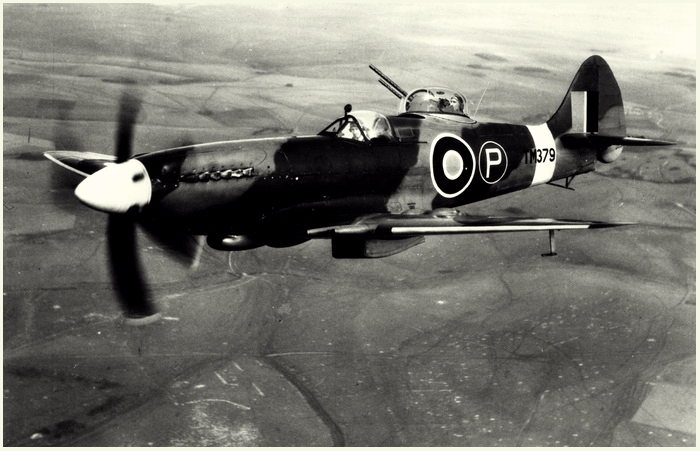
One of the vew testflights with Mk.21, TM379 and the gunturret
At a nearby American Bomber Group airbase Supermarine was aloud to rescue a Martin gunturret from a wrecked B-24 Liberator.
It was decided to try to fit it into the prototype Spitfire Mk.21, the TM379. The technical unit from Supermarine was given
four months to test out this project because TM379 was to become the maritime version F.45. There are just a couple of pictures
availabel which show the gunturret in flight. But I can't find any information if it was fired with live ammunition during
testflights.
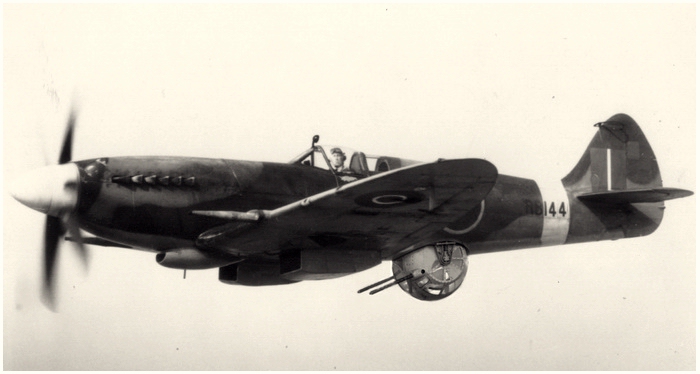
Some called the RB144 a joke and namend it 'Firefort'
It would not be the final research to some kind of movable guns for the Spitfire. De blind angle, an attack from an enemy aircraft
from below, was a weak point in the fighters from that time. Could this danger be corrected with a ballturret
underneath the fuselage of a Spitfire?
Because of the low taildragger the Spitfire was, the ballturret had to be retractable.

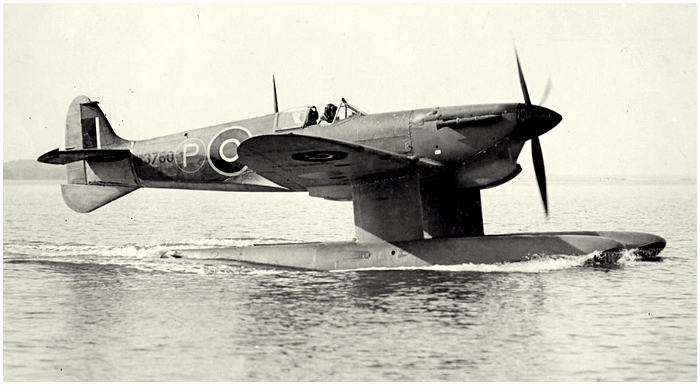
The Spitfire floatplane, nothing secret about it,... or was itl?
The Spitfire was an offspring from the Supermarine planes on floats which won the
Schneider Trophies for Britain. And so it was taken from that plans to develop a sea going aircraft which
could be used as a spotter plane with armament. There was the Seafire
which operated from aircraft carriers or land base, but this new idea was a single fighter launched from a battleship.
To test this new concept, three Mk V's and a single Mk IX were tested as floatplanes, in such places
like Egypt.
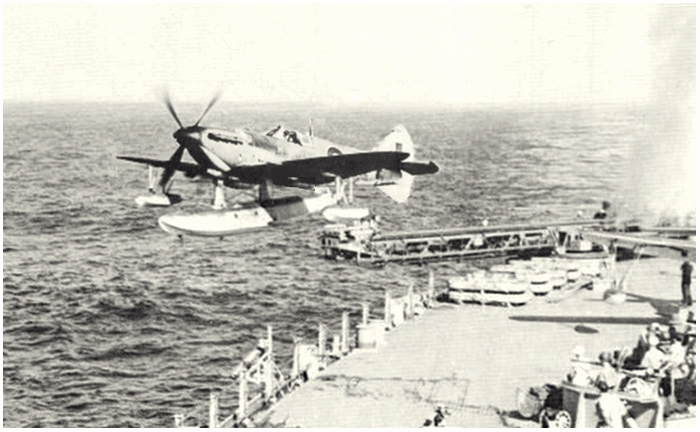
An obscure picture frame taken from a film, shot during testing of Type 889
Under the cover of that these floatplanes were developed for use in remote places where landings strips
were scares, such as the Pacific, testing was done. But the true reason was the hunt for
German U-Boats. When spotted, the Spitfire was launched, for an attack or to coordinate fire from the ship(s).
The first testing of the single Folland float Spitfire Type 889 were very promising. The follow up
on the Type 889 was the Type 890 Firecat (after 'Spitfire' and 'catapult') which were basically
F.Mk XIV's with a single Folland float.
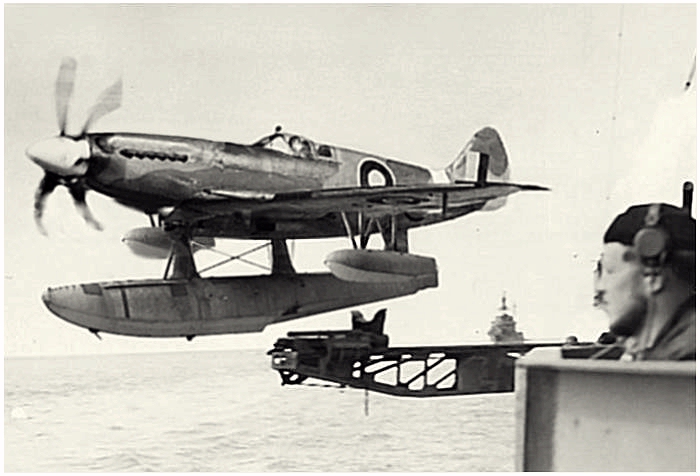
A Firecat launched from HMS Duke of York
Testing with the Firecat was done from the battleship HMS Duke of York.
Officially the Duke of York was to be deployed in 1945 to the Pacific to lead the British fleet
against Japan. But because of 'mechanical' problems it was stationed at Malta. In the Mediterranean
the testing with at least two Firecats, Type 890, were done. It was never put into production because
the war with Japan, soon was over.
A logic idea was of course to put another engine, than the Rolls-Royce Merlin and Griffon, in the Spitfire.
Just a Hawker tested other engins as the Bristol Centaurus, Vickers also tested several other manufacturers.
One of these was the Napier Sabre, double 12 cylinder, of the boxer-type with two crankshafts, which produced
2000 hp. Were those engine succesfully used in the Hawker Typhoon and Tempest, a short trial period at Vickers on a Spitfire
convinced them to stay with the more reliable Rolls-Royce engines.
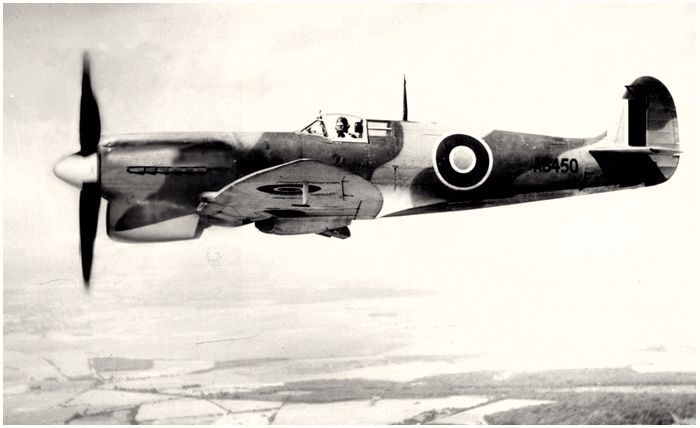
A test flight with a Napier Sabre engine
Turned out the Napier engine not be the succes they hoped for, what could be tried was to use an engine
from the enemy, like the DB 601, an engine used in the Messchermitt 109. Because Britain was at war with Germany,
one could not just order an engine from over there. The wait was for lucky break if a Bf 109 would make
an emergency landing on English soil or if one was captured.
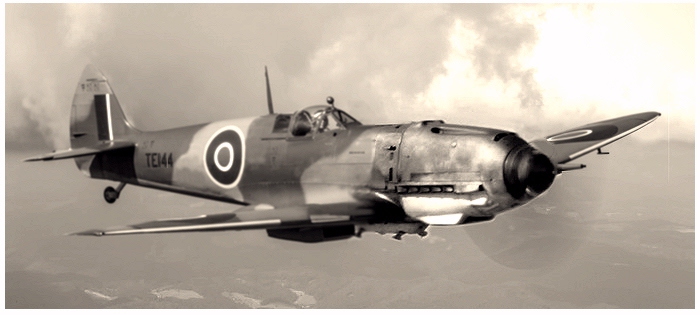
A DB-601E engine on a Spitfire during a test flight
As the drawing below from 1940 shows they the plans at the ready for a conversion with a DB 601 onto a Spitfire.
But the wait was a long one, but finaly in December 1940 an intact engine with propeller was handed over at Vickers.
The conversion to the bulkhead and the suspension for the engine, and the fuellines onto the injection system
was complicated and took a long time. But the construction was a learning curve, and some findings were
incorporated into the future Spitfire production. At the end of 1941 the first very succesfull test flight were made.
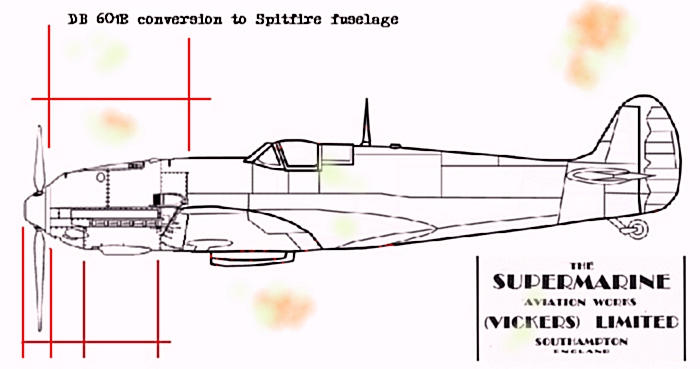
But the British engineers were not the only one who had the idea to use another enige on the Spitfire,...
On 18 November 1942 Spitfire Mk Vb, EN830, flown by P/O Bernard Scheidhauer of 131 Squadron, had made an
emergency landing on the occupied island of Jersey. During a mission over Normandy his Spitfire was hit by Flak
just as he had passed Carentan. The aircraft was shipped to Germany where it was rebuilt with a DB-605A1.
When after the war the test results were compared, the conclusion was that a German engine would work well on a British
design. It remembers one of the first Bf 109 fighters that were equipped with the Rolls-Royce Kestrel, a Britsh
engine onto a German fighter.
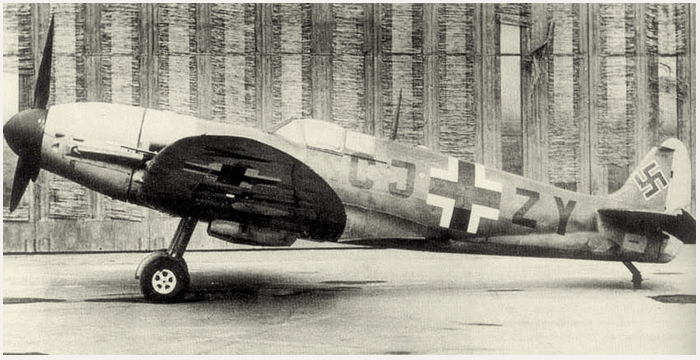
In German hands, Spitfire Mk V, EN830, equipped with a DB-605A1
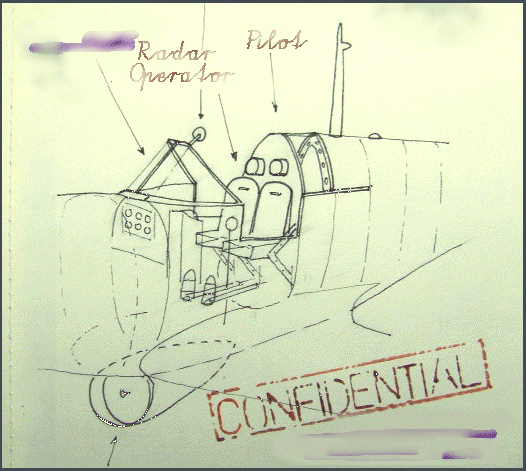
The original first sketch of the Spitfire NF Mk XXX
The standard Spitfire was not a successful nightfighter. To change this, a radar operator had to be
incorporated. The best solution seemed to be side by side. This was better than in tandem, both flyers
had a better communication this way and it was much more cosy. To accommodate the both flyers the fuselage had to be widened.

The mock-up of the Rolls-Royce Titan Mk 16
Because of the extra man on board and the heavy radar equipment, the Merlin engine was not sufficient enough, to go into
a fast pursuit towards an enemy plane. Rools-Royce suggested to take the Titan into production. This was a stretched Merlin,
with, instead of 12 cylinders it had 16 cylinder! At Vickers the engineers worked on a new layout how to incorporate
the new engine in this complete conversion idea. The bulkhead was brought back 15 inches (40 cm), the fuel tanks in front of the cockpit
were shortend, but because the fuselage became wider (to accomodate the two men in the cockpit),
the fuel tanks were also widened, and the loss of less fule was somewhat compensated.
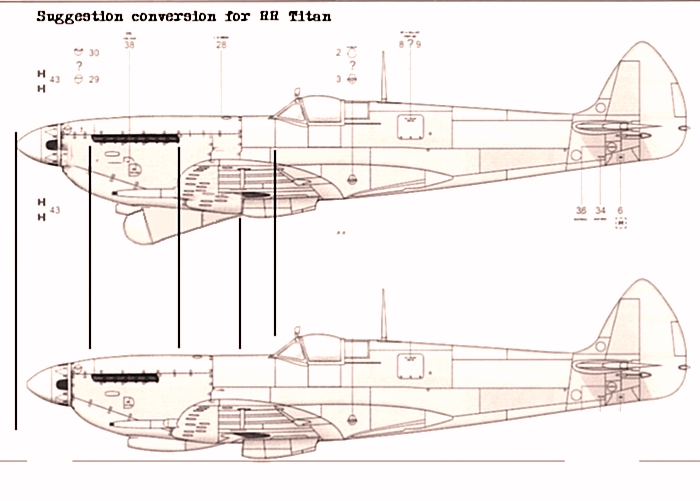
The suggestion from Vickers to widen the front of the Spitfire
(below the original standard Spitfire)
The radar, an A.I. Mk V, was installed beneath the fuselage. The information to the target from this device was
given to the pilot by the radaroperator. To accomodate the radar, the air intake should be brought to the rear (as with the
P-51 Mustang, see top of this article), but the engineers managed to built the housing of the radar around the air intake.
The drawing below showes how wide the cockpit and engine bay area became.
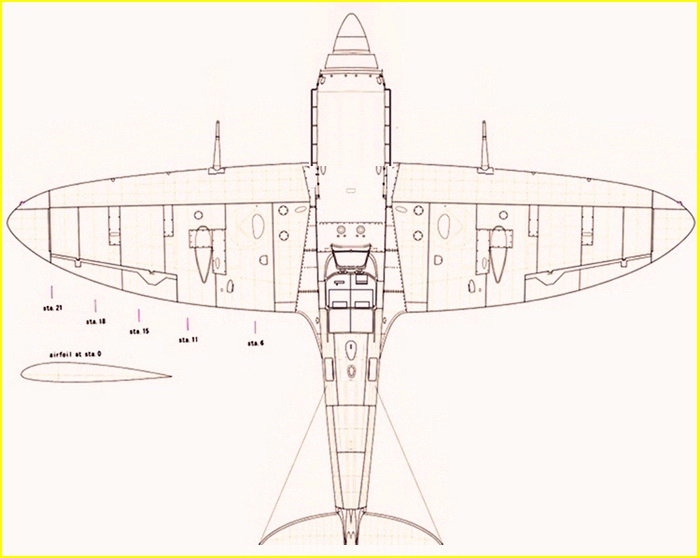
Spitfire NF Mk XXV (notice the much wider engine bay)
During the testing at Rolls-Royce
with the Titan, in a mock-up of a widened Spitfire cockpit the concept of to men beside one and another was also going through
a fase of testing. But soon it became obvious that the room was too cramped with their heavy leather jackets in the un-heated cockpit,
and frustrations run high. And when it became clear that the testing of the Titan would take much more time then was anticipated,
and Rolls-Royce had much more high hopes for the Griffon, a stronger 12 cylinder engine, the NF Mk XXV project was shelved for the
time being.
But the radar guided Spitfire was not forgotten. A proposal to let handle the pilot also the radar was worth
some testing. Spitfire Mk IX, SL666 (with the designation NF Mk XXVB) was equipped with an APS-20 Radar. First tests looked very
prommising, and the expectation was a scoring percentage of 75%.
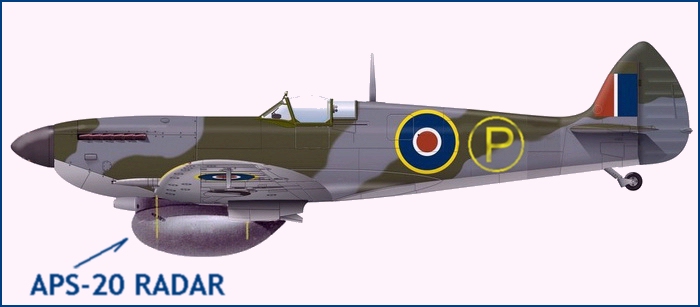
Spitfire NF Mk XXVB, SL666, no match against the Mosquito
NF Mk XXVB, SL666, with the APS-20 went for testing in March 1944 to No.219 Squadron at RAF Woodvale, a squadron that
operated with the Mosquito 30 nightfighter. The crew of a Mosquito were such a team, that operating solo by the pilot alone,
flying and operating the radar equipment could not be handled, the work force became much too high. The expected scoring percentage
was never reached, it never came above a meager 10%. The Mosquito was far better a nightfighter than the Spitfire ever woud be.
The Spitfire NF Mk XXVB development was stopped. With the Twin Spitfire an attempt for a nightfighter on paper was suggested,
but never further developed, also because the war was winding down.
One of the shortcomings of the Spitfire was her range of flying. To overcome this the Spitfire
was given droptanks. But this hindered the performance of the aircraft. A research was started to
see if it was possible to tank a Spitfire in the sky. A standard Mk IX should be converted with an
enormous fuelcell behind the pilot. A Merlin 70 had to bring the Spitfire into the air with a top
speed of 450 km/h, and rendezvous with thirsty colleagues.
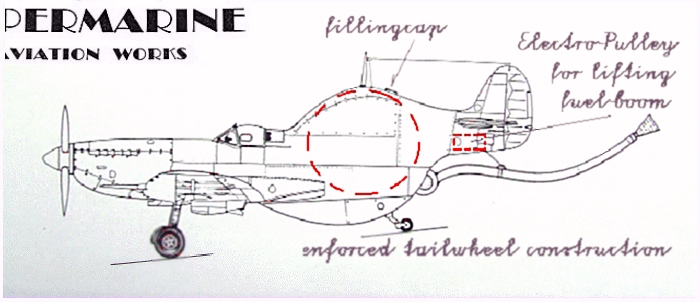
Supermarine Spitanker
A large fuel tank was built behind the cockpit. Because it was just a mock-up, no fuel pipe installation was installed.
The aerodynamics were better than expected. The airflow went smooth around the enormous ball, but the rudders reacted very slow.
The test flights were prommising, but there was a problem,...
The problem with fighters with propellers was to construct a good working probe and nozzle,
outside the propellers circle, to receive the fuel. When the P-51 Mustang with her enormous range
reached the ETO, the project was cancelled.

A test flight with the mock-up fuel tank
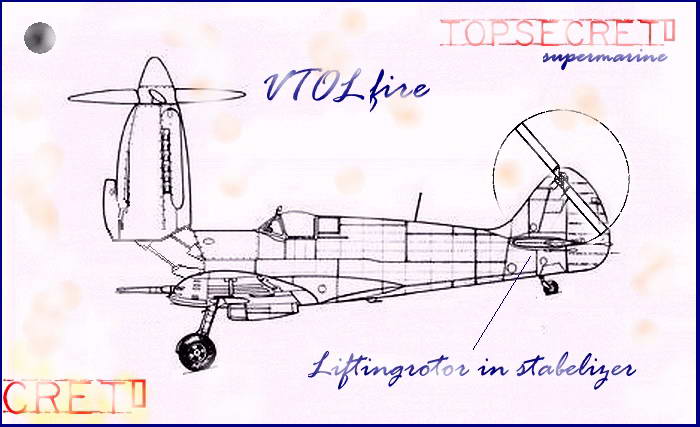
An impossible project? the VTOLflyer
The most farfetched idea by Supermarine was to convert a Spitfire as a ‘vertical takeoff’ version. This
design, the VTOLflyer (Vertical-Take-Off & Landing) was equipped with a hinged engine so the propeller
was also a lifting rotor. To prevent the fuselage from spinning, a little tail rotor was installed. For extra
lift, on both sides of the fuselage, small fans were incorporated in the stabilisers of the tailplane. In this
configuration the aircraft couldmake, more or less, a vertical takeoff. At a safe altitude the engine was brought
slowly horizontal, so the lifting smoothly went over to a pulling force and normal flight.
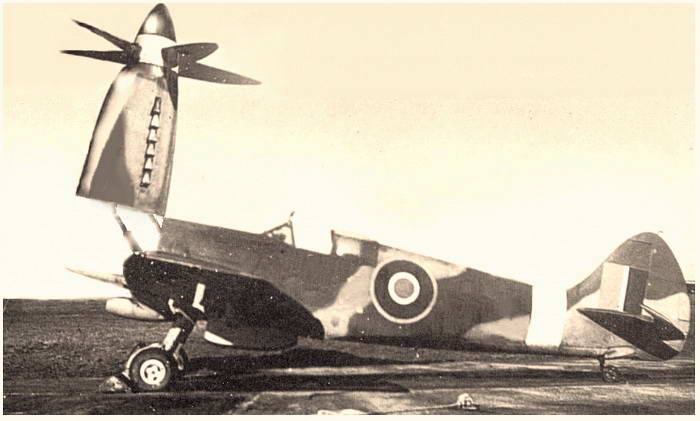
The VTOLfire in 'mock-up', still without the tailrotor
Mk VB, AB537 was set
aside for the configuration, but not used. Later Mk XIV, RN228 was used to built a mock-up, but a prototype was
never built. The idea was probably too farfetched and the whole project was silently dropped.
This is a first selection of the salvaged documents. A final picture I will share with you is Spitfire
during a test with an oil cooler on the side of the fuselage, just in front of the cockpit. There were no documents
attached to this picture, but I think it was to come to a solution to make a shortcut to the engine.
On the next page I will show some loose 'snippets', and I recommend you, no order you, to visit that page,...
(latest update; 25-12-2019)
IF YOU HAVE ANY COMMENT, MAIL ME
 I can imagine you have questions,...
I can imagine you have questions,...
For all the answers
CLICK BELOW
|